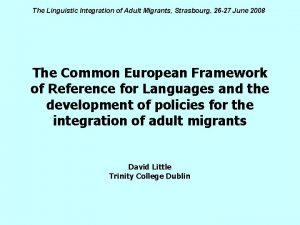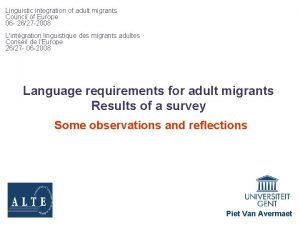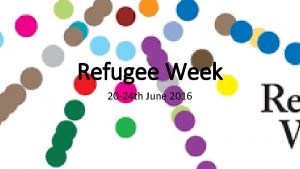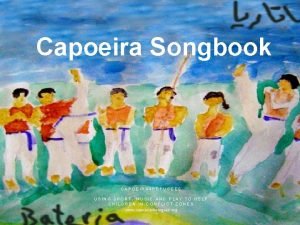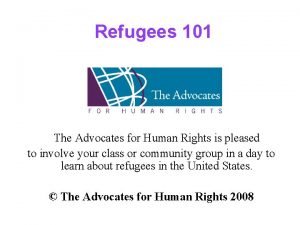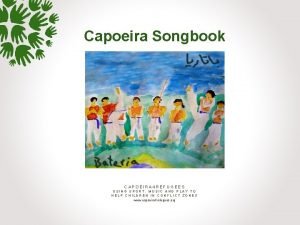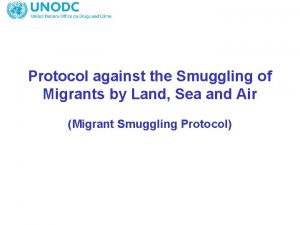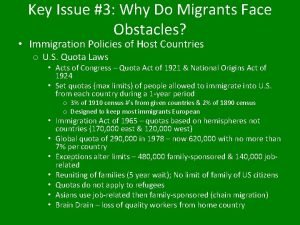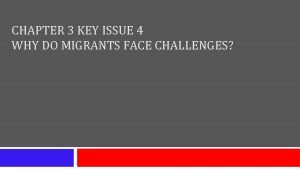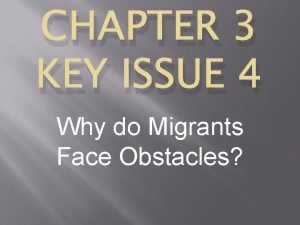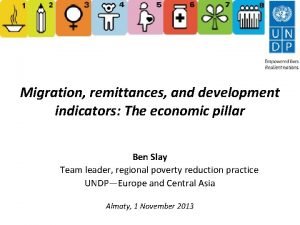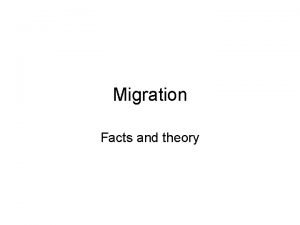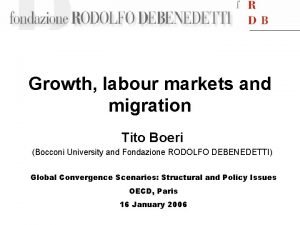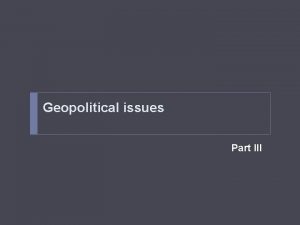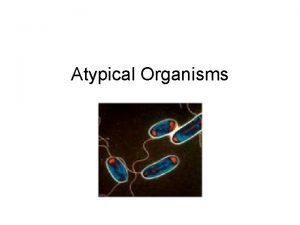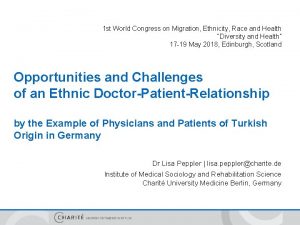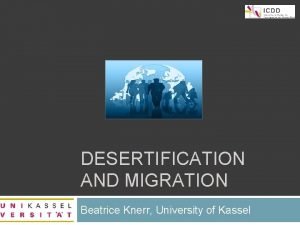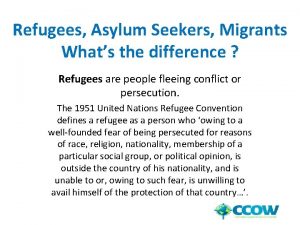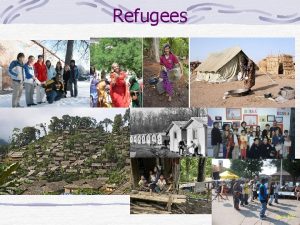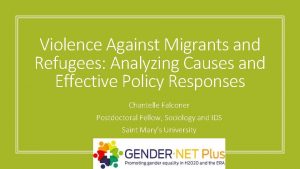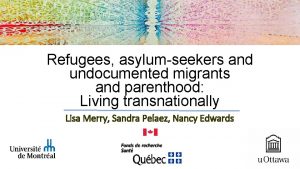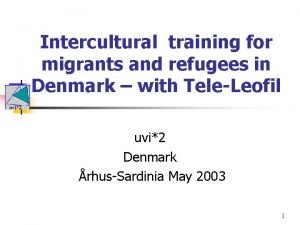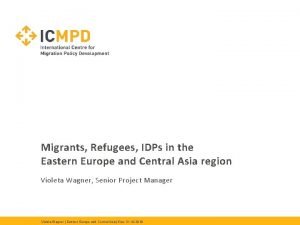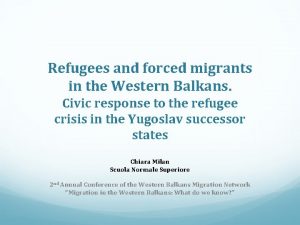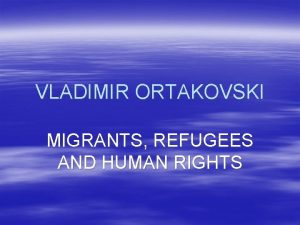Integration of Migrants and Refugees through Education Examples


















- Slides: 18


Integration of Migrants and Refugees through Education Examples of Good Practices Dr. Barbara Herzog-Punzenberger Dpt of Education, Head of Unit « Migration and Education » Johannes Kepler University Linz

Levels of Integration in Education SUPRA MACRO MESO MICRO NANO international (e. g. European Union) national (country, educational policies) organizational unit in formal education (school) classroom (interactional unit concerning teaching and learning) individual (pupil + family background)

Most important findings concerning structural issues (1) • Age of first participation in educational institutions: the earlier the better (from age 2 onwards proven in longitudinal studies e. g. EPPSE) • Quality of Early Childhood Education and Care (cognitive and socio-emotional advantage from high quality ECEC until adulthood e. g. EPPSE) • Age of first selection in the school-system (the later the better) • Duration of schooling per day (the longer the better, but no long-term effect from pre-primary)

Most important findings concerning structural issues (2) • Grade repetition does not yield any additional value • Socio-economic reproduction differs and can be moderated • No relation between share of immigrant pupils on the national level and average academic output of a country (e. g. results from large scale assessments such as PISA, TIMSS, PIRLS) • Segregation in neighbourhood, schools and classrooms impacts academic results and can be moderated

Levels of Integration in Education SUPRA international (e. g. European Union) MACRO national (country, educational policies) MESO organizational unit in formal education (school) MICRO class (interactional unit concerning teaching and learning) NANO individual (pupil + family background) >>> language acquisition in a multilingual school environment

Language acquisition in a multilingual environment – basic knowledge 1. ) The cognitive academic language proficiency CALP differs from basic interpersonal communication skills BICS 2. ) To catch up in CALP in a second language needs up to 6 years and depends on instructional provisions, support structures and individual predispositions

3. ) Fully bilingual (dual immersion) programms yield higher results, e. g. in language proficiency than all other instructional programs Þ the development of family language does not harm the development of school language Þ The academic advantage only becomes visible after six years of dual immersion Valentino & Reardon 2014, data from schools in California

Three-dimensional continuity of language education: biographic, thematic, multilingual

Selected good pratices 1) 2) 3) 4) 5) Parental involvement Mentoring (child-centered) Material Curriculum Support structures for schools

Support parental involvement 1) Information on plurilingualism for migrant parents (Norway) 2) Family literacy project (Switzerland) 3) HIPPY Home Instruction for Parents and Pre-school Youngsters (Israel, USA, NL, FRG, CH, AT, …) 4) Migrant Parents Networks MEN (Lower Saxony) 5) Parent, Family, Community Engagement Framework (US Head Start P. ) Quality in Cooperation with Parents (A Guideline for ECEC, Germany)

Mentoring (child-centered) 1) Summer-camp (Sowieso mehr. Deutsch lernen mit Spiel, Sport und Spaß; half day language, half day sports; City of Vienna, very low fees) 2) Nightingale Mentoring (students support children with low SES background and migration background AT, ES, FRG, SE, SU, CH, …) 3) The Mentoring Handbook & European Network for Educational Support Projects

Material 1) 2) Interfaith Wallchart-Calender Journal from and for 2 nd generation (e. g. biber in AT/Vienna) 3) 4) PUMA (folding-poster for language-sensitive work in ECEC) TRIO (trilingual journal for learning to read; stories constructed so that all three 5) The Media Initiative for Children Respecting Difference (Irland, ECEC langugages are needed to answer questions) & primary school, training for staff, parents and children, cartoons & dolls)

Curriculum 1) Culturally responsive curriculum 2) Multilingualism curriculum – Linguistically-sensitive subject-teaching 3) CONBAT Content Based Teaching + Plurilingual/Cultural Awareness (European Center for Modern Languages, Council of Europe)

Support structures for schools 1) Website « Schule mehrsprachig » (ministry offers all information on multilingualism legal, statistical, bibliographical, projects in schools, …) 2) VOXMI – network of schools which engage in mulitlingual schooling sustained by the ministry and local authorities 3) Federal Center for interculturality, migration and multilingualism BIMM Resource center for teacher training institutions, teacher educators, networking of responsible 4) QUIMS Quality in multicultural schools (Zurich, CH) obligatory for schools with 40%+ migrant pupils: additional budget, personal resources for coordination, training of teachers, work with parents

Teacher competences and training 1) Sprachkopf (Germany): Test for teachers concerning their language competences, i. e. knowledge and skills, diagnose gaps and provaid training 2) Heidelberger Interaktionstraining für pädagogisches Fachpersonal to support mono- and multilingual children => language use of personal is crucial! training has to be directed towards everyday interaction, it has to last minimum 6 days over at least six months with regular meetings to discuss implementation 3) Da. ZKom – competence model for teachers in grade 5 -8 to learn language-sensitive subject teaching 4) Intercultural opening up of schools (Hamburg, Germany): (1) awareness-raising and self-reflection concerning bias and stereotypes, (2) intercultural whole-school development, (3) change management 5) ECML European Framework for Content and Language integrated learning CLIL

…finally teacher-education and training leadership in whole-school development AND system-wide commitment are the key!

Thank for You attention! your
 Linguistic integration of adult migrants
Linguistic integration of adult migrants Impact of integration
Impact of integration Refugees brian bilston lesson
Refugees brian bilston lesson Immigration policies ap human geography definition
Immigration policies ap human geography definition Capoeira songbook
Capoeira songbook Refugees
Refugees Capoeira songbook
Capoeira songbook Protocol against the smuggling of migrants
Protocol against the smuggling of migrants Why do migrants face obstacles
Why do migrants face obstacles Chapter 3 key issue 4
Chapter 3 key issue 4 Key issue 4 why do migrants face obstacles
Key issue 4 why do migrants face obstacles Migrants
Migrants Migrants
Migrants Migrants
Migrants Migrants
Migrants Diseases
Diseases Migrants
Migrants Migrants
Migrants Forward integration and backward integration
Forward integration and backward integration
